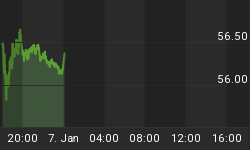Following is an excerpt from Pivotal Events published September 23, 2004by InstitutionalAdvisors.
"Too much prosperity makes men greedy and desires are never controlled sufficiently to stop at the point of attainment." - Seneca (4 BC-AD 65)
Preface: Occasionally we mention that the investment world is much larger than the focus upon equities would suggest. In particular, during and following a "new" financial era, the play in stocks is very dependent upon the action in the credit markets. Unfortunately, the equity culture becomes overly enthused about all the good news being generated by corporate and economic results as well as being far too reliant upon the abilities of senior central bankers.
The problem with this limited view is that at important stock market bottoms, earnings and the economy typically decline for some months after the trough in the stock market. Often, as the consensus waits for the good numbers, the stock market is enjoying the initial rally of a new bull market.
Going the other way, the stock market leads by a number of months the orthodox measures of earnings, economy, and policymaker boasting.
Watching the wrong but conventional items can be hazardous and this is why we have done a lot of work on commodity prices and credit conditions, which have often anticipated disappointment in equity land.
This week's edition will start with the financial sector but, before this, it is worth noting that the stock market, commodities, and credit spreads seem to be setting a big test of highs set earlier in the year.
INTEREST RATES
Credit Spreads: This sector was likely to participate in the August revival of the "good stuff". The action has been vigorous enough to generate this week's glowing storylines: "Junk Bonds Gain Luster as Investors Seek Yield". This became a little zesty this week with the observation "There is still tremendous demand out there that has not been met."
The latter relates to the fact that a growing number of corporations are building cash rather than borrowing to expand plant and equipment; therefore, a lower supply of junk. On the former, the compulsion to reach for yield at the top of a business cycle usually suggests untimely confidence.
At times such as this year, it can be a winner. For example, since early 1998 the DJIA has gained 3%, 10-year treasuries are up 7.5%, with emerging debt making a big one at +22%. According to a September 12 WSJ review by Merrill Lynch, "Emerging-Market Bonds Handle Rate Increases".
This continued on Tuesday's increase, but the enthusiastic headlines and the technical aspects of the big test of previous highs suggests picking up the pace of selling risk.
The high-yield spread set what is most likely a cyclical low at 194 bps, over treasuries, at the end of January. This then widened to 295 bps in May, from which it came in to 235 bps on September 15. With a couple of zig-zags, it has widened to 247 bps yesterday. A tested reversal to widening over the next few weeks seems likely and we would take this as a warning of a developing liquidity problem.
The Yield Curve: This action is fascinating. Typically, as a business boom matures the yield curve flattens or even inverts as short rates rise relative to longs. This we have but, also typically, this is accomplished as both short and long rates increase.
On this one, it has been different. The bill yield has increased from 0.98% in May to 1.71% this week as the 30-year has decreased 77 beeps to 4.78%. By this measure, the curve has flattened from 457 bps to 308 bps.
With this, the more widely followed (30-yr. to 2-yr.) segment has flattened from 302 bps to 232 bps yesterday. On the move, the 10-year yield has declined from 4.85% to 3.98%.
The point to be made is the one we hammered in the first half of 2000. When the curve inverts, a recession follows and, in many examples, all it took was the curve approaching inversion. The instruction from the past is that the key is not so much whether inversion occurs, but when the reversal to steepening happens it signals the end of the party.
It seems that the best explanation that the curve has not inverted is because "the world"1 has been buying longer dated treasuries. This segment has been one of the party animals.
In the summer of 2000, Wall Street pundits were very distressed about the increase in Fed funds from 5 ½ % to 6%. Our advice then was that rising rates indicated that the party was still on. The worry should be about bill rates reversing to a decline.
On the big picture, it is usually sound to ignore changes in the Fed rate and its associated comments and watch for the reversal in the curve.
The change to steepening and spread widening will signal a pending liquidity crisis.
The Bond Future: In a year that has featured a series of speculative spikes, it is likely that the uptrend in long government prices would conclude with some excitement. This seems to be happening with some big players on the wrong side.
"A broad swath of participants seriously misjudged the market's ability to rally in the face of Fed tightening." - WSJ, September 23, 2004
Well, the Fed is again getting in line with the trend in short-dated market rates of interest. The term "Fed tightening" may not be accurate. Yes, the administered rate was increased, but that the Fed is voluntarily tightening is doubtful.
Traders can ride the rally for another week. Levente will advise.















